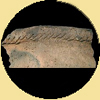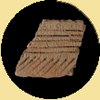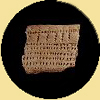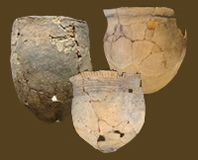
|
Clemson Island:
An early Late Woodland ware characterized by crushed rock temper with cord-marked or fabric-impressed surface treatments. One of the most distinctive features of Clemson Island pottery (but not necessarily found on all types) is a row of punctations and/or raised nodes/bosses below the lip or on the upper rim.
|

|
Minguannan:
A Late Woodland ware, characterized by sand, quartz, or grit temper, cord-marked or fabric-impressed exterior surfaces, and broad line, incised direct cord and pseudo cord decorations. Defined types include Minguannan Plain, Minguannan Compound Decorated, Minguannan Incised, and Minguannan Corded.
|

|
Shenks Ferry:
A Late Woodland ware characterized by crushed granite or quartz temper and a cord-marked exterior with the cords aligned vertically to the vessel. Decoration consists of incised lines in geometric patterns encircling the rim. Defined types include Shenks Ferry Cord-Marked, Shenks Ferry Incised, Lancaster Plain and Lancaster Incised.
|

|
Page:
An early Late Woodland ware, characterized by limestone temper and a cord-marked exterior surface, often with an added strip or pseudo-collar around the rim. Decorative techniques include cord-wrapped stick impressions or incising on the lip and rim exterior, and rarely lugs or castellations.
|

|
Sullivan Cove:
A Late Woodland ware, characterized by fine shell tempering, thin vessel walls, a hard compact paste, conoidal bases, and cord-wrapped paddle impressions on the exterior surface. Defined types consist of Sullivan Cove Cord-Marked and Sullivan Cove Plain.
|

|
Keyser:
A Late Late Woodland ware, characterized by shell temper, a cord-marked exterior often over-stamped obliquely, a notched lip surface, and a wide mouthed globular body and rounded base. Variations include plain-surfaced exteriors.
|

|
Shepard:
A Late Woodland ware, characterized by quartz and/or crushed igneous rock temper and a cord-marked exterior surface. Vessels often have added collars (applied strips of clay on the exterior of the rims).
|

|
Moyaone:
A Late Woodland ware, characterized by fine grained sand and mica temper, soft texture, compact paste, and smoothed interior and exterior surfaces. Defined types include Moyaone Plain, Moyaone Cord-Impressed, and Moyaone Incised.
|

|
Yeocomico:
A shell-tempered Late Woodland ware characterized by smooth, scraped-smooth or cord-marked surfaces. Defined types include Yeocomico Plain, Yeocomico Scraped, and Yeocomico Cord-Marked.
|

|
Townsend Series:
Late Woodland to Early Contact-period wares, characterized by shell temper, fabric-impressed exterior surfaces, and various decorative motifs. Defined types include Rappahannock Fabric-Impressed, Rappahannock Incised, Rappahannock Plain, Townsend Herringbone, and Townsend Corded-Horizontal.
|

|
Potomac Creek:
A Late Woodland ware, characterized by a crushed quartz or sand temper, cord-marked exteriors, and rim strips (collars). Defined types include Potomac Creek Plain and Potomac Creek Cord-Marked.
|

|
Monongahela:
A complex series that begin with an early grit or limestone tempered group and end with a very anomalous collection of types found in southwestern Pennsylvania during the post-Contact period. The earliest Drew phase ceramics of the Middle to Late Woodland transition exhibit incising on the exterior surfaces, sometimes in rectilinear zoned patterns.
|


